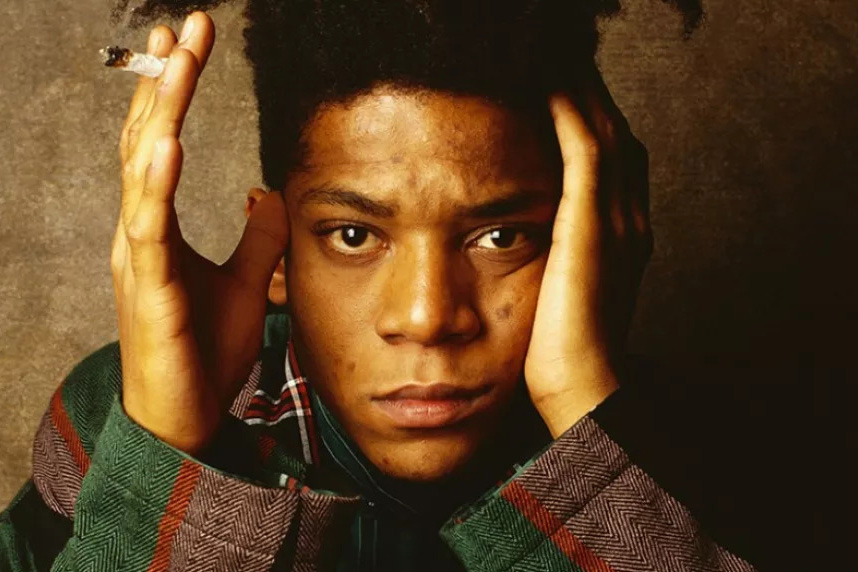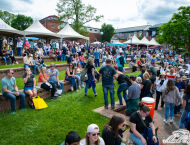Culture
 Jean-Michel Basquiat. Photo courtesy of film.
Jean-Michel Basquiat. Photo courtesy of film.
New French Film Focuses on Jean-Michel Basquiat’s Reciprocal Influence on African Art
July 27, 2022 @ 10:00am
Bold. Frenetic. Rebellious. Jean-Michel Basquiat entered the 1980s Neo-expressionism movement in New York City looking to upend the art world. His emblematic graffiti-style works broke the conventional academic rules of painting. Though his life was cut short at the age of 27 from a heroin overdose, his legacy as a pop icon and the first Black fine artist to reach international celebrity acclaim has had a lasting effect.
“He didn’t just open the doors, he removed the doors,” remarked an Ivorian artist about Basquiat’s influence on Black artists in the upcoming film, “Jean-Michel Basquiat, Africa at Heart.”
The French film, which will be available to stream on TV5MONDEplus on August 1, explores the reciprocal influence between Basquiat and African culture and artistry. On July 25, Eaton DC hosted a preview screening with the film’s director Cyril Bérard.
Separated into three sections, the first focuses on Basquiat’s life and how African art impacted his own. Basquiat was half-Haitian and half-Puerto Rican and grew up primarily in Brooklyn, New York. He only visited Africa in 1986 after he was an already established artist, but Basquiat always felt connected to the continent and looked to its many cultures as sources of inspiration.
Prior to the visit Basquiat famously stated, “I’ve never been to Africa. I’m an artist who has been influenced by his New York environment. But I have a cultural memory. I don’t need to look for it; it exists. It’s over there, in Africa. That doesn’t mean I have to go live there. Our cultural memory follows us everywhere, wherever you live.”
The cultural memory Basquiat speaks of can be seen throughout his art which includes nods to African spiritual masks, and other symbolic and tribal imagery used in his paintings. The film also notes that he carried books about African history with him wherever he went. Though, it is not always clear how intentional Basquiat was with some of the references to African culture in his works.
“It’s quite complicated to try to understand his reasoning because Basquiat had a very short life and he would not speak about his work,” Bérard said at the screening. “When people asked him about his work, he just said, ‘Everything I need to say is there in the painting.’ So some references can be misunderstood, and even art critics have some difficulty.”
Bérard used the example of SAMO, the graffiti tag Basquiat signed his early works with on the streets of New York City.
“We all know SAMO stood for ‘same old sh-t,’ but in fact, there’s also a language taught in West Africa called Samo. So did Basquiat know about the language? I don’t know. No one knows. And that’s the beauty of Basquiat. He’s very mystical and very secretive.”
What is known is that Basquiat visited the Ivory Coast in October 1986 to show his work at the French Cultural Center in Abidjan. The second part of the film focuses on Basquiat’s 10-day trip and tries to capture Basquiat’s experience, as well as locals’ experience with encountering his art for the first time.
Several Ivorian artists from the Vohou Vohou movement were interviewed about their reaction to Basquiat’s 1986 exhibit. The Vohou Vohou movement followed a similar philosophy to Basquiat in that they pushed against conventional art practices and worked with their surrounding materials, like using crate wood for canvasses.
“He gave fresh blood to art,” said one Vohou Vohou artist, who met Basquiat on his trip, although due to the language barrier, the exchange was limited. He saw Basquiat’s work no different to what they were trying to achieve with their artwork.
Others were not initially as enthused, with many critics and the public noting Basquiat’s exhibit was “strange” and “childlike.” Most people living in the Ivory Coast pre-social media days were unaware of Basquiat’s celebrity status and were quick to dismiss him.
However, the most compelling aspect of the film is the third section, which focuses on Basquiat’s impact on African artists, posthumously. Whatever the opinions are about Basquiat’s actual art, there is unanimous agreement that he helped foster an interest for investing and teaching art in the Ivory Coast, which led to a generation of internationally famous Ivorian artists. This was highlighted towards the end of the film when a group of students at the Fine Arts at Harris School of Modern in Abidjan, list artists like Armand Boua, Aboudia, and Outtara Watts as people they look up to.
“It’s something very beautiful,” Bérard said. “Because, African artists who grew up in the ’90s directly following Basquiat, most of them, only had western references [for inspiration]. Less than 20 years after that, the young African artists now have their own role models and their own references.”
“L’Afrique au coeur is Basquiat, Africa at the Heart” (subtitled in English) will be available to watch on August 1 on the French streaming service TV5MONDEplus.
Eaton DC: 1201 K St. NW; eatonworkshop.com // @eaton.dc
Enjoy this piece? Consider becoming a member for access to our premium digital content. Support local journalism and start your membership today.







